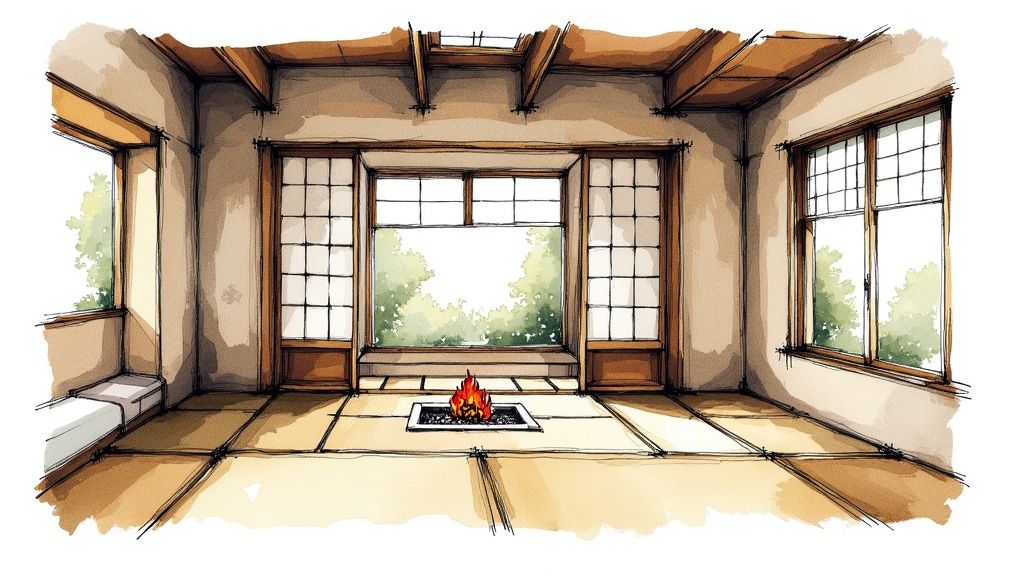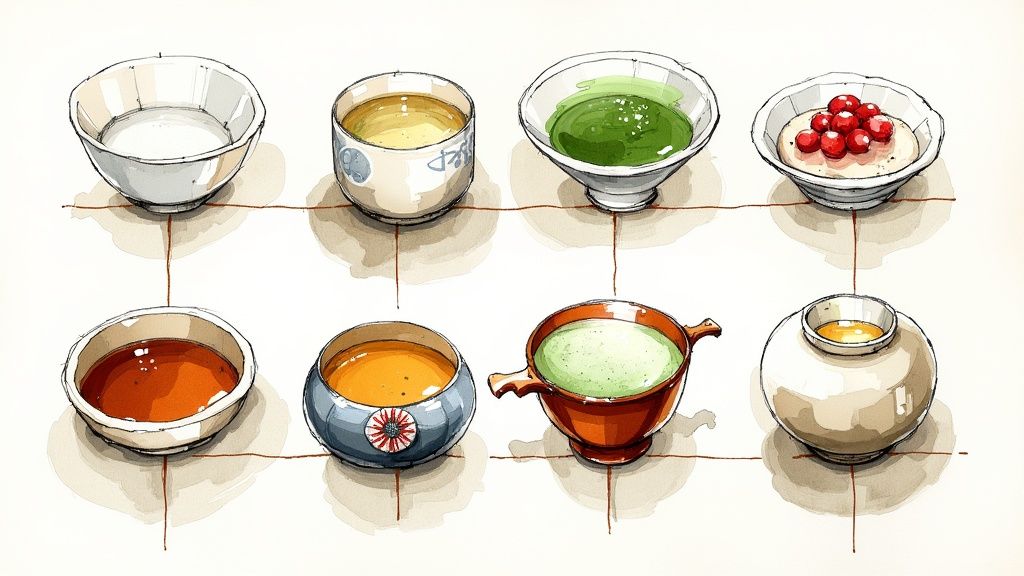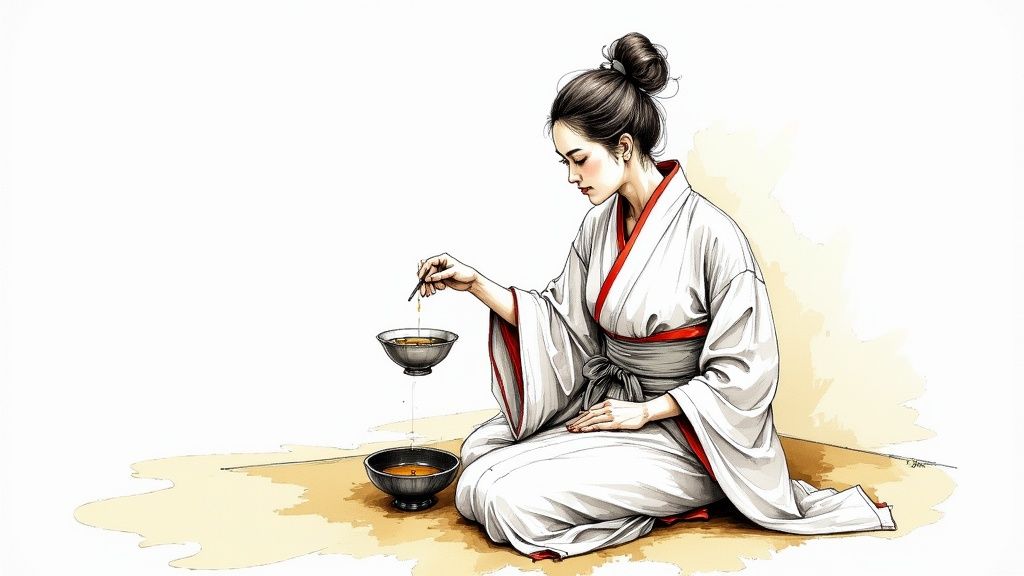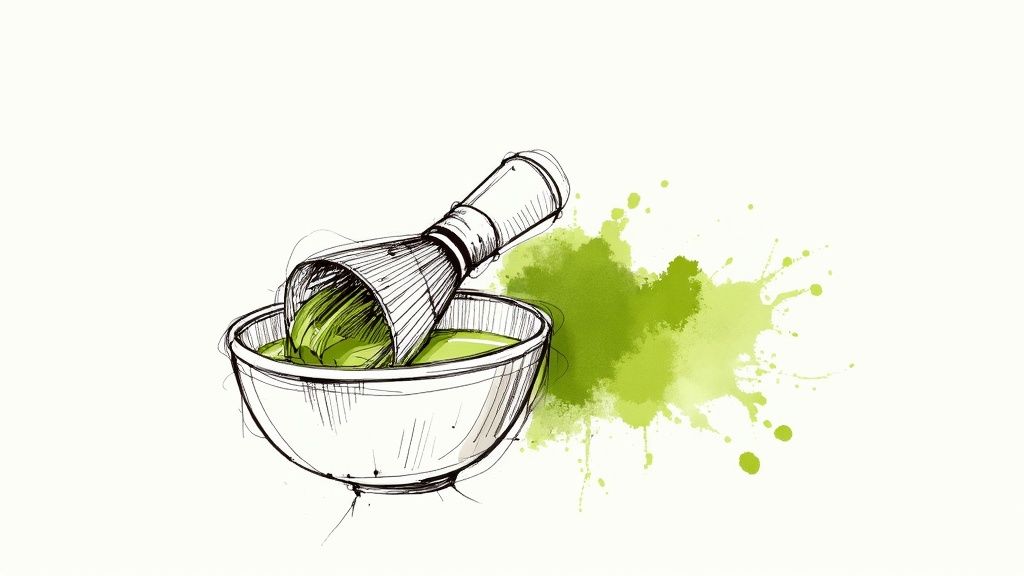Understanding the Heart of Chado

The Japanese tea ceremony, known as Chado (the Way of Tea), represents something much deeper than just drinking tea. This carefully crafted ritual embodies centuries of Japanese cultural traditions and Zen Buddhist principles. Beginning in 9th-century Japan after its introduction from China, the ceremony has grown into a rich art form that connects people through shared experience. For those interested in exploring its history further, here's an excellent resource: The Origin of Japanese Tea Ceremony. Let's explore the key elements that make Chado such a meaningful practice.
The Four Pillars of Chado
At its core, the tea ceremony rests on four essential principles: wa (harmony), kei (respect), sei (purity), and jaku (tranquility). These values shape every aspect of the ceremony. The host creates harmony by thoughtfully arranging the tea space and selecting seasonal elements. Respect flows naturally between host and guests, extending to the tea implements and centuries-old traditions. Physical and spiritual purity emerge through careful cleaning rituals and moments of quiet reflection. As the ceremony unfolds, these elements come together to create a sense of deep peace and tranquility.
The Influence of Zen Buddhism
Zen Buddhist teachings profoundly shape the tea ceremony's character. The practice emphasizes being fully present, finding beauty in simplicity, and moving with purpose and awareness. Inside the tea room, each precise movement, the gentle whisking of tea, and moments of shared silence create space for meditation and reflection. This mindful approach helps participants step away from daily concerns and connect with themselves and others more deeply.
The Role of Aesthetics
Beauty holds special significance in Chado. Each element – from hand-crafted tea bowls to seasonal flower arrangements (ikebana) and carefully chosen calligraphy in the tokonoma (alcove) – adds to the ceremony's refined atmosphere. Even the traditional sweets (wagashi) complement the tea's flavor and reflect the current season. This attention to visual and sensory details creates a complete experience that engages all the senses while celebrating simple, natural beauty.
From Samurai to Modern Practice
The tea ceremony first gained prominence among Japan's samurai class, who valued it as a way to develop discipline and cultural refinement while building social bonds. Though deeply rooted in tradition, the ceremony continues to resonate with modern practitioners. People from all backgrounds now participate, finding that its emphasis on presence and connection offers welcome relief from daily pressures. The enduring appeal of this centuries-old practice shows how its core wisdom remains relevant across time.
Creating the Perfect Tea Space
The practice of tea ceremony comes alive in its physical setting. A well-designed tea room, or chashitsu, sets the stage for meaningful encounters and embodies the core values of wa (harmony), kei (respect), sei (purity), and jaku (tranquility). Creating this space requires attention to both practical elements and subtle details that shape the experience.
Essential Elements of the Tea Room
At the heart of a traditional tea room lies a thoughtful arrangement of key features. Tatami mats made from woven rice straw cover the floor, guiding participants' movements throughout the ceremony. A tokonoma alcove anchors the space, displaying seasonal flower arrangements (ikebana) and carefully selected calligraphy that reflect nature's rhythms. The ro, a small sunken hearth, not only provides warmth in winter but also adds gentle sounds and aromas that deepen the sensory experience.

Adapting Tradition for Modern Spaces
While a dedicated chashitsu offers the fullest expression of tea ceremony, modern practitioners find creative ways to honor its spirit in everyday settings. A quiet corner of a home can become a tea space with thoughtful touches – a simple screen creates boundaries, while soft lighting and minimal decor foster focus and calm. This flexibility means that anyone, even in a small apartment, can experience the peace of Chado in their own way.
Creating the Right Atmosphere
The mood within the tea space shapes the ceremony as much as its physical features. Natural light filtered through paper screens creates gentle shadows, while empty space allows the mind to settle. Small sounds become meaningful – water warming in the kama (iron kettle), the bamboo whisk stirring matcha, brief moments of silence. These elements work together to encourage mindfulness and connection between host and guests. For those interested in exploring these traditions further, matcha-tea.com offers detailed insights into tea culture and related Japanese arts like pottery and seasonal festivals. What matters most is how the space supports genuine presence and shared experience among those who gather there.
Mastering Essential Movements and Tools
The heart of the Japanese tea ceremony lies in understanding its core movements and tools. When you grasp how each utensil works together and master the careful motions, you begin to see the true beauty of Chado unfold before you.
Essential Tools of the Tea Ceremony
Each tool in Chado tells its own story and plays a vital part in bringing the ceremony to life. Like pieces of art, these tools carry deep meaning beyond their practical use.
-
The Chawan (Tea Bowl): Each tea bowl is crafted by hand, making it one-of-a-kind. Its unique shape and texture add layers to how you experience the tea, from its warmth in your hands to how it touches your lips.
-
The Chasen (Tea Whisk): Made from a single bamboo stalk, this delicate whisk turns matcha powder and water into a smooth, frothy drink. Taking good care of your whisk helps it serve you well.
-
The Chashaku (Tea Scoop): This bamboo scoop measures out just the right amount of matcha for each serving. Its simple design shows how precision matters in every detail.
-
The Chaki (Tea Caddy): Here's where the matcha powder stays fresh until the moment of preparation. Tea masters often choose caddies that match the current season or the specific tea being served.
-
The Kama (Iron Kettle): As water warms in this kettle, its soft bubbling creates a peaceful backdrop to the ceremony. Placed over charcoal, it becomes the ceremony's beating heart.
The way these tools work together shows how each small part matters to the whole experience.
Mastering the Movements
Think of the tea ceremony as a gentle dance where every step has purpose. When you clean the tools with the fukusa silk cloth or whisk the matcha to perfection, you're part of a tradition that values each careful movement. Take the way you hold the whisk – it's not just about making tea, but creating the right texture and taste. Even turning the tea bowl before drinking shows respect for everyone sharing in the ceremony.
Common Mistakes and How to Avoid Them
When starting out, small errors can throw off the ceremony's peaceful flow. Many beginners squeeze the tea whisk too hard, which can break its fine tines. Try thinking of the whisk as flowing from your hand naturally, rather than as something to control. Another easy mistake is forgetting to turn the tea bowl properly – this simple gesture matters because it shows you care about the shared moment. Getting these details right helps everything flow smoothly.
As you practice these movements and work with the tools, you'll start to feel the deeper meaning in each part of the ceremony. For more insights into Japanese tea traditions, visit matcha-tea.com. When you put time into learning these basics, you'll find yourself connecting more deeply with the spirit of Chado.
The Art of Seasonal Expression

The Japanese tea ceremony moves and changes with the seasons, like nature itself. Each gathering tells the story of a particular moment in time through carefully chosen elements that capture the essence of spring, summer, autumn, or winter. This connection to the natural world gives the practice its remarkable depth and beauty.
Embracing Nature's Palette
The tea room comes alive through seasonal touches in every detail – from the tea bowls and sweets (wagashi) to the decorative elements that set the mood. In spring, you might find yourself drinking light usucha (thin tea) from a bowl painted with delicate cherry blossoms, while enjoying wagashi molded into the shape of spring flowers. These choices create an experience that celebrates new beginnings and fresh growth.
The tokonoma (alcove) plays an essential role in this seasonal expression. A carefully chosen scroll showing spring scenes or poetry might hang beside freshly picked seasonal flowers. Together, these elements bring the spirit of springtime directly into the tea room.
Adapting to Summer's Warmth
Summer brings its own character to the tea ceremony. Cool colors and lightweight materials help create a sense of refreshment, while the kama (iron kettle) moves from its winter home in the sunken hearth to a portable brazier that better suits warmer days. Many hosts offer chilled usucha during hot weather, paired with wagashi that feature cooling ingredients like mint or summer fruits.
Autumnal Hues and Winter Warmth
As autumn arrives, the tea ceremony shifts to deeper, earthier elements. The tokonoma might showcase a scroll depicting fall leaves or harvest themes, while the wagashi incorporate seasonal flavors like chestnut or sweet potato. Winter brings a different mood entirely – the ro (sunken hearth) returns as the ceremony's heart, offering warmth and comfort. This is the perfect season for rich koicha (thick tea) served in sturdy bowls that hold their heat well, reflecting winter's quiet, introspective nature.
Building a Versatile Collection
To practice tea ceremony throughout the year, it helps to build a thoughtful collection of implements that can adapt to each season. While having special seasonal pieces enhances the experience, some core items work well year-round. A simple chawan (tea bowl) in neutral tones can pair beautifully with seasonal chashaku (tea scoops) or chaki (tea caddies). By starting with these essential pieces and slowly adding seasonal elements, you can create meaningful ceremonies that honor nature's changes. To learn more about building your collection and understanding different tea traditions, visit matcha-tea.com.
Building Meaningful Connections Through Tea
The Japanese tea ceremony, known as Chado, creates deep bonds between people through the simple act of sharing tea. At a time when many of us feel disconnected despite constant online interactions, this ancient practice provides a rare space for genuine human connection. By bringing people together in shared moments of mindfulness, Chado helps bridge differences and build lasting relationships.
Welcoming First-Time Guests and Managing Group Dynamics
Making newcomers feel comfortable is essential for a successful ceremony. When hosts take time to explain the key principles – wa (harmony), kei (respect), sei (purity), and jaku (tranquility) – guests better understand and appreciate each part of the experience. This simple introduction helps put everyone at ease and sets the tone for meaningful exchange.
Like a skilled conductor, the host guides the gathering's flow while ensuring everyone feels included. They might gently draw quieter participants into the conversation or smoothly redirect discussions that stray too far from the ceremony itself. The peaceful atmosphere naturally encourages attentive listening and thoughtful dialogue between guests.
Creating Memorable and Inclusive Experiences
While rooted in tradition, the tea ceremony welcomes people from all backgrounds. Seasonal touches like fresh flowers, calligraphy scrolls, and wagashi (sweets) spark natural conversations and shared appreciation. Offering both usucha (thin tea) and koicha (thick tea) lets guests explore different flavors based on their preferences. For those wanting to learn more about tea practices, matcha-tea.com offers helpful resources.
The ceremony can be thoughtfully adapted while staying true to its essence. This might mean serving a guest's favorite tea alongside traditional matcha or sharing stories about tea customs from different cultures. The goal is to honor the tradition while creating a welcoming space where everyone feels valued.
Building a Supportive Tea Community
Beyond single gatherings, regular tea ceremonies help form lasting friendships and community bonds. As people come together repeatedly to share tea, they develop deeper connections and learn from one another's experiences. This shared practice creates a sense of belonging that many find grounding in their busy lives.
These connections now extend across borders through online tea communities. Social media groups and forums let practitioners worldwide share knowledge and celebrate their love of Chado. By linking people across distances, these networks keep the tradition alive and relevant for future generations. The tea ceremony thus offers both immediate human connection and lasting community ties that enrich our shared experience.
Preserving Tradition in Modern Practice

At first glance, the meticulous rituals and mindful presence required by the Japanese tea ceremony may seem challenging to maintain in our busy modern lives. Yet Chado continues to flourish by thoughtfully balancing time-honored traditions with contemporary needs. This careful evolution allows the ceremony to stay meaningful and relevant while preserving its essential spirit.
Bridging the Gap Between Past and Present
Tea practitioners face real challenges in maintaining authentic Chado practices, especially outside Japan where traditional tea rooms (chashitsu) are scarce. Many have found creative solutions, like transforming a peaceful home corner into a dedicated tea space using simple screens and natural elements to capture the ambiance of a chashitsu. While the precise movements and etiquette remain fundamental, some schools now offer slightly modified approaches that work better with modern schedules. This flexibility helps preserve the core principles of harmony (wa), respect (kei), purity (sei), and tranquility (jaku) in ways that fit contemporary life.
Incorporating Chado Principles into Daily Life
The wisdom of the tea ceremony extends far beyond formal settings. Its lessons in mindfulness, respect, and harmony can enrich everyday moments. For example, taking time to carefully select and prepare tea, even informally, becomes a chance for quiet reflection. Paying attention to water temperature, savoring aromas, and drinking mindfully transforms a simple tea break into a peaceful ritual. These principles can also enhance other daily activities, from cooking meals to spending time with others.
The Evolution of Tea Schools
Traditional schools like Urasenke and Omotesenke play a key role in preserving Chado while making it accessible to modern students. These institutions teach the rich history, philosophy and hands-on aspects of the ceremony, covering everything from proper etiquette to seasonal variations. While maintaining deep respect for established practices, they recognize the need to adapt. Many now offer online resources and updated teaching methods to support practitioners in different cultural contexts.
Embracing the Future of Chado
The continued relevance of the Japanese tea ceremony depends on finding the right balance between tradition and adaptation. By staying true to its principles while thoughtfully evolving, Chado can keep offering its gifts of mindfulness and connection to new generations. Growing interest in mindful practices suggests more people will discover the ceremony's value as a path to finding peace and meaning. To learn more about matcha and its cultural traditions, visit matcha-tea.com for detailed information on tea varieties, preparation methods, and ceremonial arts.
Ready to explore tea culture yourself? Find carefully selected matcha, beautiful teaware, and helpful resources at matcha-tea.com to deepen your connection with Chado's rich heritage.
